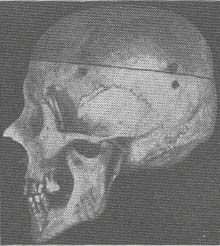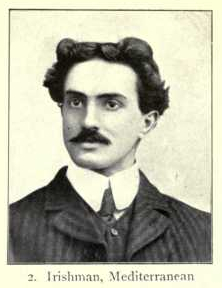|
Joseph Deniker
Joseph Deniker (russian: Иосиф Егорович Деникер, ''Yosif Yegorovich Deniker''; 6 March 1852, in Astrakhan – 18 March 1918, in Paris) was a Russian and French naturalist and anthropologist, known primarily for his attempts to develop highly detailed maps of race in Europe. Life Deniker was born in 1852 to French parents in Astrakhan, Russian Empire. He first studied at the university and technical institute of St. Petersburg, where he adopted engineering as a profession, and in this capacity traveled extensively in the petroleum districts of the Caucasus, in Central Europe, Italy and Dalmatia. Settling at Paris, France in 1876, he studied at the Sorbonne, where he received a doctorate in natural science in 1886. In 1888 he was appointed chief librarian of the Natural History Museum in Paris. Deniker became one of the chief editors of the ''Dictionnaire de geographie universelle'', and published many papers in the anthropological and zoological journals of ... [...More Info...] [...Related Items...] OR: [Wikipedia] [Google] [Baidu] |
Joseph Deniker
Joseph Deniker (russian: Иосиф Егорович Деникер, ''Yosif Yegorovich Deniker''; 6 March 1852, in Astrakhan – 18 March 1918, in Paris) was a Russian and French naturalist and anthropologist, known primarily for his attempts to develop highly detailed maps of race in Europe. Life Deniker was born in 1852 to French parents in Astrakhan, Russian Empire. He first studied at the university and technical institute of St. Petersburg, where he adopted engineering as a profession, and in this capacity traveled extensively in the petroleum districts of the Caucasus, in Central Europe, Italy and Dalmatia. Settling at Paris, France in 1876, he studied at the Sorbonne, where he received a doctorate in natural science in 1886. In 1888 he was appointed chief librarian of the Natural History Museum in Paris. Deniker became one of the chief editors of the ''Dictionnaire de geographie universelle'', and published many papers in the anthropological and zoological journals of ... [...More Info...] [...Related Items...] OR: [Wikipedia] [Google] [Baidu] |
Natural Science
Natural science is one of the branches of science concerned with the description, understanding and prediction of natural phenomena, based on empirical evidence from observation and experimentation. Mechanisms such as peer review and repeatability of findings are used to try to ensure the validity of scientific advances. Natural science can be divided into two main branches: life science and physical science. Life science is alternatively known as biology, and physical science is subdivided into branches: physics, chemistry, earth science, and astronomy. These branches of natural science may be further divided into more specialized branches (also known as fields). As empirical sciences, natural sciences use tools from the formal sciences, such as mathematics and logic, converting information about nature into measurements which can be explained as clear statements of the " laws of nature". Modern natural science succeeded more classical approaches to natural philosophy, usua ... [...More Info...] [...Related Items...] OR: [Wikipedia] [Google] [Baidu] |
Dinaric Race
The Dinaric race, also known as the Adriatic race, were terms used by certain physical anthropologists in the early to mid-20th century to describe the perceived predominant phenotype of the contemporary ethnic groups of southeast Europe (a sub-type of the Caucasoid race). History and physiognomy The concept of a Dinaric race originated with Joseph Deniker in the late 19th century, but became most closely associated with the writings of Carleton S. Coon and Nazi eugenicist Hans F. K. Günther. The term was derived from the Dinaric Alps (the western part of Southeastern Europe) which was supposed to be the principal habitat of the race. According to Jan Czekanowski, the Dinaric race is a mixed type consisting of the Nordic race and Mediterranean race, which he proves by anthropological research involving geographical data, cephalic index, and characteristic racial features. He states: The Dinaric type is characterized by quite light skin, dark hair from dark brown to dark bl ... [...More Info...] [...Related Items...] OR: [Wikipedia] [Google] [Baidu] |
Early Slavs
The early Slavs were a diverse group of tribal societies who lived during the Migration Period and the Early Middle Ages (approximately the 5th to the 10th centuries AD) in Central and Eastern Europe and established the foundations for the Slavic nations through the Slavic states of the High Middle Ages. The Slavs' original homeland is still a matter of debate due to a lack of historical records; however, scholars believe that it was in Eastern Europe, with Polesia being the most commonly accepted location. The first written use of the name "Slavs" dates to the 6th century, when the Slavic tribes inhabited a large portion of Central and Eastern Europe. By then, the nomadic Iranian-speaking ethnic groups living on the Eurasian Steppe (the Scythians, Sarmatians, Alans etc.) had been absorbed by the region's Slavic-speaking population. Over the next two centuries, the Slavs expanded west to the Elbe river and south towards the Alps and the Balkans, absorbing the Celtic, Ger ... [...More Info...] [...Related Items...] OR: [Wikipedia] [Google] [Baidu] |
East Baltic Race
The East Baltic race is one of the subcategories of the Europid race, into which it was divided by biological anthropologists and scientific racists in the early 20th century. Such racial typologies have been rejected by modern anthropology for several reasons. The term East Baltic race was coined by the anthropologist Rolf Nordenstreng, but was popularised by the race theorist Hans F. K. Günther. This race was living in Finland, Estonia and Northern Russia. And was present among Slavic, Baltic, Uralic and even some individual Germanic people (I.E Prussian and Swedish locals who immigrated in the area throughout medieval and early modern history) of the Baltic sea. It was characterised as "short-headed, broad-faced, with heavy, massive under-jaw, chin not prominent, flat, rather broad, short nose with low bridge; stiff, light ( ash-blond) hair; light (grey or pale blue) eyes, standing out; light skin with a greyish undertone. The American Eugenics Society described East Baltic ... [...More Info...] [...Related Items...] OR: [Wikipedia] [Google] [Baidu] |
Mediterranean Race
The Mediterranean race (also Mediterranid race) was a historical race concepts, historical race concept that was a sub-race of the Caucasian race as categorised by anthropology, anthropologists in the late 19th to mid-20th centuries. According to various definitions, it was said to be prevalent in the Mediterranean Basin and areas near the Mediterranean Sea, Mediterranean, especially in Southern Europe, North Africa, most of Western Asia, the Middle East or Near East; western Central Asia, parts of South Asia, and parts of the Horn of Africa. To a lesser extent, certain populations of people in Ireland, western parts of Great Britain, and Southern Germany, despite living far from the Mediterranean, were thought to have some minority Mediterranean elements in their population, such as Bavaria, Wales, and Cornwall.The Races of Europe by Carleton S. Coon, Carlton Stevens Coon. From Chapter XI: The Mediterranean World – Introduction: "The next strip to follow, in a geographical sense, ... [...More Info...] [...Related Items...] OR: [Wikipedia] [Google] [Baidu] |
Nordic Race
The Nordic race was a racial concept which originated in 19th century anthropology. It was considered a race or one of the putative sub-races into which some late-19th to mid-20th century anthropologists divided the Caucasian race, claiming that its ancestral homelands were Northwestern and Northern Europe, particularly to populations such as Anglo-Saxons, Germanic peoples, Balts, Baltic Finns, Northern French, and certain Celts and Slavs. The supposed physical traits of the Nordics included light eyes, light skin, tall stature, and dolichocephalic skull; their psychological traits were deemed to be truthfulness, equitability, a competitive spirit, naivete, reservedness, and individualism. In the early 20th century, the belief that the Nordic race constituted the superior branch of the Caucasian race gave rise to the ideology of Nordicism. With the rise of modern genetics, the concept of distinct human races in a biological sense has become obsolete. In 2019, the American Asso ... [...More Info...] [...Related Items...] OR: [Wikipedia] [Google] [Baidu] |
Peoples Of Europe
Europeans are the focus of European ethnology, the field of anthropology related to the various ethnic groups that reside in the states of Europe. Groups may be defined by common genetic ancestry, common language, or both. Pan and Pfeil (2004) count 87 distinct "''peoples of Europe''", of which 33 form the majority population in at least one sovereign state, while the remaining 54 constitute ethnic minorities. The total number of national minority populations in Europe is estimated at 105 million people, or 14% of 770 million Europeans.Christoph Pan, Beate Sibylle Pfeil (2002), Minderheitenrechte in Europa. Handbuch der europäischen Volksgruppen', Braumüller, (Google Books, snippet view). Als2006 reprint by Springer(Amazon, no preview) . The Russians are the most populous among Europeans, with a population of roughly 120 million. There are no universally accepted and precise definitions of the terms "ethnic group" and "nationality". In the context of European ethnography in ... [...More Info...] [...Related Items...] OR: [Wikipedia] [Google] [Baidu] |
William Z
William is a male given name of Germanic origin.Hanks, Hardcastle and Hodges, ''Oxford Dictionary of First Names'', Oxford University Press, 2nd edition, , p. 276. It became very popular in the English language after the Norman conquest of England in 1066,All Things William"Meaning & Origin of the Name"/ref> and remained so throughout the Middle Ages and into the modern era. It is sometimes abbreviated "Wm." Shortened familiar versions in English include Will, Wills, Willy, Willie, Bill, and Billy. A common Irish form is Liam. Scottish diminutives include Wull, Willie or Wullie (as in Oor Wullie or the play ''Douglas''). Female forms are Willa, Willemina, Wilma and Wilhelmina. Etymology William is related to the given name ''Wilhelm'' (cf. Proto-Germanic ᚹᛁᛚᛃᚨᚺᛖᛚᛗᚨᛉ, ''*Wiljahelmaz'' > German '' Wilhelm'' and Old Norse ᚢᛁᛚᛋᛅᚼᛅᛚᛘᛅᛋ, ''Vilhjálmr''). By regular sound changes, the native, inherited English form of the name should ... [...More Info...] [...Related Items...] OR: [Wikipedia] [Google] [Baidu] |
Academic Journal
An academic journal or scholarly journal is a periodical publication in which scholarship relating to a particular academic discipline is published. Academic journals serve as permanent and transparent forums for the presentation, scrutiny, and discussion of research. They nearly-universally require peer-review or other scrutiny from contemporaries competent and established in their respective fields. Content typically takes the form of articles presenting original research, review articles, or book reviews. The purpose of an academic journal, according to Henry Oldenburg (the first editor of ''Philosophical Transactions of the Royal Society''), is to give researchers a venue to "impart their knowledge to one another, and contribute what they can to the Grand design of improving natural knowledge, and perfecting all Philosophical Arts, and Sciences." The term ''academic journal'' applies to scholarly publications in all fields; this article discusses the aspects common to al ... [...More Info...] [...Related Items...] OR: [Wikipedia] [Google] [Baidu] |
Zoology
Zoology ()The pronunciation of zoology as is usually regarded as nonstandard, though it is not uncommon. is the branch of biology that studies the animal kingdom, including the structure, embryology, evolution, classification, habits, and distribution of all animals, both living and extinct, and how they interact with their ecosystems. The term is derived from Ancient Greek , ('animal'), and , ('knowledge', 'study'). Although humans have always been interested in the natural history of the animals they saw around them, and made use of this knowledge to domesticate certain species, the formal study of zoology can be said to have originated with Aristotle. He viewed animals as living organisms, studied their structure and development, and considered their adaptations to their surroundings and the function of their parts. The Greek physician Galen studied human anatomy and was one of the greatest surgeons of the ancient world, but after the fall of the Western Roman Empire ... [...More Info...] [...Related Items...] OR: [Wikipedia] [Google] [Baidu] |






